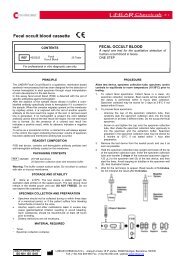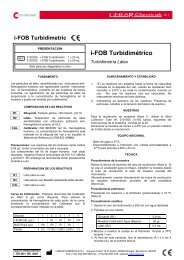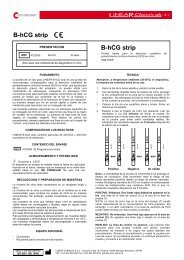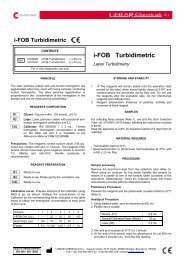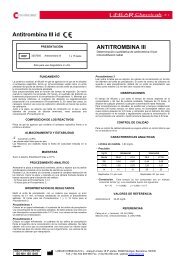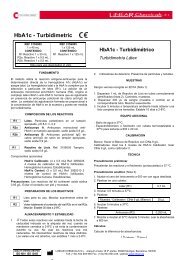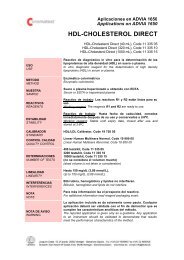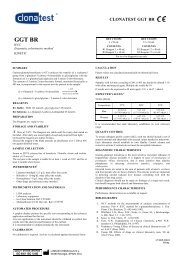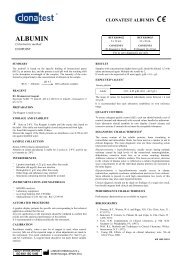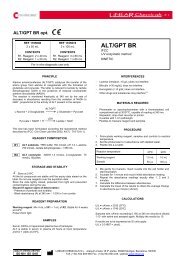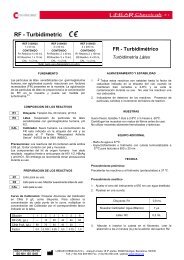HbA1c Turbidimetric - Linear
HbA1c Turbidimetric - Linear
HbA1c Turbidimetric - Linear
You also want an ePaper? Increase the reach of your titles
YUMPU automatically turns print PDFs into web optimized ePapers that Google loves.
<strong>HbA1c</strong> <strong>Turbidimetric</strong>REF 3155005 REF 31560051 x 40 mL 1 x 125 mLCONTENTSCONTENTSR1.Reagent 1 x 30 mL R1. Reagent 1 x 125 mLR2a. Reagent 1 x 9,5 mLR2b. Reagent 1 x 0,5 mLFor in vitro diagnostic use only<strong>HbA1c</strong> <strong>Turbidimetric</strong>Latex TurbidimetryPRINCIPLEThis method directly determinates the hemoglobin A1c(<strong>HbA1c</strong>) in whole blood, using an antigen and antibodyreaction. Total hemoglobin and <strong>HbA1c</strong> compite for theunspecific absortion rate to the latex particles (R1). Whenanti-human <strong>HbA1c</strong> monoclonal antibody is added (R2), latex-<strong>HbA1c</strong>-anti-human <strong>HbA1c</strong> antibody complex is formed. Thepresence of goat anti-mouse IgG polyclonal antibody causesthe agglutination of the particles (complexes).The amount ofagglutination is proportional to the concentration of the<strong>HbA1c</strong> in the sample and can be measured by turbidimetry.R1R2aR2bR1REAGENTS COMPOSITIONLatex Suspension. Polystyrene particles in abuffer, stabilizer. pH 8.0 +/- 0.2Antibody A. Mouse anti-human <strong>HbA1c</strong> monoclonalantibody in a buffer, sodium azide 0.9 g/L.Antibody B. Goat anti-mouse IgG polyclonalantibody in a buffer, sodium azide 0.9 g/L.Optional Components:Lyse Reagent. Ref: 3156005 Buffer, sodiumazide 0.9 g/L.<strong>HbA1c</strong> Calibration Set. (4 x 0,5 mL) Ref:39550054 levels of lyophilized <strong>HbA1c</strong> calibrators preparedfrom human erythrocytes. Contain stabilizers.<strong>HbA1c</strong> Control Set. (2 x 0,5 mL) Ref: 3955010 2Levels of of lyophilized <strong>HbA1c</strong> controls preparedfrom human erythrocytes. Contain stabilizers.Precautions: The reagents contain sodium azide 0.95 g/L.Avoid any contact with skin or mucous.R1R2REAGENT PREPARATIONReady to use. Mix thoroughly before use.Pour the total volume of R2b vial into the R2a vial.Stable 30 days at 2-8º C.STORAGE AND STABILITY1. The reagents will remain stable until the expirationdate printed on the label, when stored tightly closed at 2-8ºC and contaminations are prevented during their use.Opened vials are stable 1 month when stored at 2-8ºC.Do not use the reagents after the expiration date. Do notinterchange reagents from different lots.2. Reagent deterioration: Presence of particles, turbidity andincrement of blank reagent.SAMPLESVenous blood collected with EDTA (Note 1).1. Dispense 1 mL Lyse Reagent into labeled tubes (Note 2):Controls, or patient samples.2. Place 20 µL of well mixed blood (patient sample or controls)to each tube. Mix.3. Incubate for 5 minutes at room temperature until completelysis is evident. Stable 10 days at 2-8ºC.CALIBRATIONBlank: Make Reagent Blank with distilled water.Calibrators: Use the 4 levels of <strong>HbA1c</strong> Calibrator. Use ClNa9 g/L as calibrator 0.MATERIAL REQUIRED- Thermostatic bath at 37ºC.- Spectrophotometer or photometer thermostatable at 37ºCwith a 600 ± 20 nm filter.PROCEDUREPreliminary ProcedurePrewarm the reagents and the photometer (cuvette holder) to37ºCAnalitycal Procedure (Note 3).1. Using distilled water, zero de intrument at 600 nm2. Pipette into a cuvette:Latex suspension (R1)3. Incubate 3-5 minutes at 37ºC.4. Pipette:0.7 mLSample / Calibrator / Water (Blank) 20 µL5. Incubate 5 minutes at 37ºC.6.Pipette:Antibody (R2)0.250 mL7. Mix well and incubate at 37ºC for 5 minutes. At the end ofthis period, read the absorbance (A) at 600 nm.QUALITY SYSTEM CERTIFIEDISO 9001 ISO 13485LINEAR CHEMICALS S.L. Joaquim Costa 18 2ª planta. 08390 Montgat, Barcelona, SPAINTelf. (+34) 934 694 990 Fax. (+34) 934 693 435. website www.linear.es
CalculationCalculate the absorbance difference:(A Calibrator – A Blank )of each point of the calibration curve and plot the valuesobtained against the <strong>HbA1c</strong> concentration of eachcalibrator. <strong>HbA1c</strong> concentration in the sample is calculatedby interpolation of its (A sample – A Blank ) in the calibration curve.QUALITY CONTROLS<strong>HbA1c</strong> Controls are recommended to monitor theperformance of manual and automated assay procedures. Itis recommended to use <strong>HbA1c</strong> Control Set (ref: 3955010).Each laboratory should establish its own Quality Controlscheme and corrective actions if controls do not meet theacceptable tolerances.Every six months, linearity of the assay should be verifiedwith a commercial linearity check set, or dilutions of a highspecimen.REFERENCE VALUESTable below indicates the cut-off values establishedbytheDiabetes Control and Complications Trial Research Group(DCCT) and have been adopted for a reference population/non-diabetic) and for the evaluation of the degree bloodglucose control in diabetic patients 2,5 .(%) DCCT / NGSP (%) IFCC Degree of control4.0 – 6.0 2.0 – 4.2 Non Diabetic6.0 – 6.5 4.2 – 4.8 Goal6.5 – 8.0 4.8 – 6.4 Good Control> 8.0 > 6.4 Action suggestedEach laboratory should establish its own expected values(Note 4 and 5).CLINICAL SIGNIFICANCE<strong>HbA1c</strong> is the product of the irreversible condensation ofglucose with the N-terminal residue of β-chain ofhemoglobin A. The concentration of <strong>HbA1c</strong> is directlyproportional to the concentration of glucose in the blood,and represents the integrated values for glucose over thepreceding 6 to 8 week. <strong>HbA1c</strong> values are free of day-to dayglucose fluctuations and unafected by exercise or recentfood ingestion. The determination of <strong>HbA1c</strong> is mostcommonly performed for the evaluation of glycemic controlin dibatic patients, althogh is not adequated for diabetesmellitus control. A higher HbA1 value indicates poorerglycemic control. This process, reflects the averageexposure of hemoglobin to glucose over an extendedperiod. <strong>HbA1c</strong> in diabetic subjects use to be elevated 2-3fold over the levels founs in nomal individuals 1 . <strong>HbA1c</strong> serveas an indicator of metabolic control of the diabetic, since<strong>HbA1c</strong> levels approach normal values for diabetics inmetabolic control. 2-4ANALYTICAL PERFORMANCE- Measurement range. 2.0% - 16.0 % under the describedassay conditions (Note 6). Samples with higherconcentrations should be diluted 1/2 en ClNa 9 g/L andretested again.- Analytical sensitivity. 0.073 Ab / 1.0% <strong>HbA1c</strong>.- Precision (NCCLS protocol EP5, Hitachi 917).Media (%) DE (%) CV (%)4.76 0,06 1,26Intra-ensayoN = 20Inter-ensayoN = 207.29 0,08 1,1010.9 0,16 1,464.72 0,06 1,277.36 0,08 1,0911.0 0,17 1,55- Accuracy. 40 human samples have been tested with thismethod compared to automated HPLC procedure (Toshoh),yielding a correlation coefficient of 0.988 and a linearregression equation ofy = 1.050x – 0.481 (Sxy=0.332)- Interferences. Bilirubin (50 mg/dL), ascorbic ac. (50 mg/dL),triglycerides (2000 mg/dL), carbamylated Hb (7.5 mmol/L),acetylated Hb (5.0 mmol/L), uremia and labile intermediates(Schiff base), do not interfere. Hemoglobin variants HbA2,HbC and HbS do not interfere. Other rare hemoglobins(e.g. HbE) have not been studiedOther substances or drugs may interfere. 11LIMITATIONS1. Opiate addition, lead-poisoning, alcoholism, high dose ofaspirin, may give false results 6-9 .2. High levels of HbF, may lead to underestimation of<strong>HbA1c</strong> 11 .NOTES1. <strong>HbA1c</strong> in whole blood collected with EDTA is stable for oneweek at 2-8ºC.2. Plastic or glass tubes are acceptable.3. This method may be used with different instruments. Anyapplication to an instrument should be validated todemonstrate that results meets the performancecharacteristics of the method. It is recommended to validateperiodically the instrument. Contact to the distributor for anyquestion on the application method.4. In using <strong>HbA1c</strong> to monitor diabetic patients, results shouldbe interpreted individually. That is, the patient should bemonitored againts himself. There is a 3-4 week time lagbefore <strong>HbA1c</strong> reflects changes in blood glucose level.5.Clinical diagnosis should not be made on findings of asingle test result, but should integrate both clinical andlaboratory data.6.The linearity limit depends on the sample/reagent ratio, aswell as the analyzer used. It will be higher by decreasingthe sample volume, although the sensitivity of the test willbe proportionally decreased.BIBLIOGRAPHY1. Trivelli LA at al. New Engl J Med 1971; 284: 353.2. Gonen B and Rubisntein AH. Diabetology 1978; 15: 1.3. Gabby KH, at al. J Clin Endocrinol Metab 1977; 44: 859.4. Bates HM. Lab Mang 1978; vol 16.5. Tietz NW. Textbook of Clinical Chemistry, Philadelphia WB.Saunders Company 1999: 794-795.6. Little RR, et al. Clin Chem 1986;32: 358-360.7. Fluckiger, R et al. New Eng J Med 1981; 304: 823-827.8. Nathan DM, et al. Clin Chem 1989; 35: 93-97.9. Engbaek F, et al. Clin Chem 1989; 35: 93-97.10.American Diabetes Association: Clinical PracticeRecommendations (Position Statement). Diabetes Care 2001;Suppl 1: S33-S55.11.Young DS. Effects of drugs on clinical laboratory tests. 3th ed.AACC Press (1997).T3155-1/0903R1.ingQUALITY SYSTEM CERTIFIEDISO 9001 ISO 13485LINEAR CHEMICALS S.L. Joaquim Costa 18 2ª planta. 08390 Montgat, Barcelona, SPAINTelf. (+34) 934 694 990 Fax. (+34) 934 693 435. website www.linear.es



